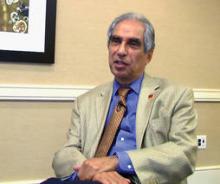The target range for serum thyrotropin levels in nonpregnant adults should be the normal range of a third-generation assay, and if an upper limit of normal for the assay is unspecified, the limit should be considered 4.12 mIU/L in iodine-sufficient areas, according to new clinical practice guidelines issued jointly by the American Association of Clinical Endocrinologists and the American Thyroid Association.
Thus, the new guidelines "take the middle ground" with respect to the controversy over what the upper limit of normal is for serum thyrotropin (TSH) levels, Dr. Hossein Gharib of the Mayo Clinic, Rochester, Minn., said in an interview.
The reference range is generally considered to be between 2.5 and 5 mIU/L by laboratories that perform the tests, he noted.
The recommendation (#17) is one of 34 main recommendations and 18 subrecommendations included in the new guidelines. It is a Grade B recommendation with a Best Evidence Level (BEL) of 2, indicating that the evidence is limited but based on prospective controlled trials with or without randomization.
The evidence-based guidelines, developed by a task force of expert clinicians appointed by the American Association of Clinical Endocrinologists (AACE) and the American Thyroid Association (ATA), represent a joint effort by these organizations to address the etiology and epidemiology of hypothyroidism, as well as clinical and laboratory evaluation, management, and consequences of hypothyroidism.
Topics addressed by the guidelines include everything from screening to treatment of subclinical disease to pregnancy-related concerns, according to lead author Dr. Jeffrey R. Garber, the task force chair, and his colleagues (Endocr. Pract. 2012;18:988-s4).
"We covered a wide range of issues important to clinical endocrinologists," said Dr. Gharib, a task force member as well as past president of the AACE and president-elect of the ATA.
Other recommendations within the guidelines that Dr. Gharib highlighted address the use of thyroxin monotherapy, management of subclinical disease, and management of hypothyroidism in pregnancy.
Thyroxin monotherapy
Thyroxin monotherapy, rather than combination therapy, is preferred in patients with hypothyroidism, according to the guidelines.
This represents an endorsement of current practice, Dr. Gharib said.
Specifically, recommendations 22.1 and 22.2 state that patients with hypothyroidism should be treated with L-thyroxine monotherapy and that the evidence does not support using L-thyroxine and L-triiodothyronine combinations to treat hypothyroidism (Grade A, BEL 1 [indicating the evidence is based on large, randomized controlled prospective trials] and Grade B, BEL 1, respectively).
Subclinical hypothyroidism
Subclinical hypothyroidism, defined by TSH above normal when T3 and T4 are normal, usually involves mildly elevated TSH at between 5 and 10 mIU/L. Controversy has existed over whether treatment or observation is best in these patients, Dr. Gharib explained.
Recommendation 16 of the guidelines states that treatment should definitely be considered in those with TSH above 10 mIU/L, particularly if the patient has symptoms suggestive of hypothyroidism; positive anti-microsomal/anti-thyroid peroxidase antibodies (TPOAb); or evidence of atherosclerotic cardiovascular disease, heart failure, or associated risk factors for these diseases (Grade B, BEL 1).
Pregnancy
With respect to pregnancy, the new recommendations underscore the fact that TSH levels differ between pregnant and nonpregnant women, Dr. Gharib said.
Recommendation 18 states that reference levels should be adjusted based on trimester-specific TSH values. If trimester-specific reference ranges are not available from a given laboratory, the following upper-normal reference limits should be used: 2.5 mIU/L for the first trimester, 3.0 mIU/L for the second trimester, and 3.5 mIU/L for the third trimester (Grade C, BEL 2).
"These guidelines are a document that reflects the current state of the field and are intended to provide a working document for guideline updates since rapid changes in this field are expected in the future. We encourage medical professionals to use this information in conjunction with their best clinical judgment," the authors wrote, noting that the recommendations may not be appropriate in all situations.
"Any decision by practitioners to apply these guidelines must be made in light of local resources and individual patient circumstances," they added.
Areas for future research include the evaluation of possible cardiac and cognitive benefit from treating subclinical hypothyroidism, combination therapy for hypothyroidism, monotherapy with L-triiodothyronine, the use of thyroid hormone antagonists in therapy, screening for hypothyroidism in pregnancy, and agents and conditions impacting therapy and interpretation of thyroid tests, they noted.
These guidelines were cosponsored by the AACE and the ATA. One task force member, Dr. Jeffrey I. Mechanick, reported receiving speaker and program development honoraria from Abbott Nutrition. The remaining task force members reported having no disclosures.


